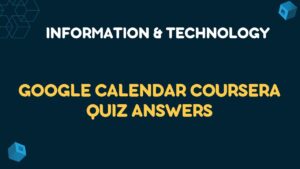Table of Contents
All Weeks AWS Cloud Technical Essentials Coursera Quiz Answers
Week 1 Quiz Answers
Q1. What are the four main factors you should take into consideration when choosing a Region?
- Latency, high availability, taxes, and compliance
- Latency, taxes, speed, and compliance
- Latency, security, high availability, and resiliency
- Latency, price, service availability, and compliance
Q2. True or false: Every action you take in AWS is an API call.
- True
- False
Q3. Which of the following best describes the relationship between Regions, Availability Zones and data centers?
- Data centers are cluster of Availability Zones. Regions are clusters of Availability Zones.
- Regions are clusters of Availability Zones. Availability Zones are clusters of data centers.
- Availability Zones are clusters of Regions. Regions are clusters of data centers.
- Data centers are clusters of Regions. Regions are clusters of Availability Zones.
Q4. Which of the following is a benefit of cloud computing?
- Run and maintain your own data centers.
- Go global in minutes.
- Increase time-to-market.
- Overprovision for scale.
Q5. True or false: In the cloud, instead of physically managing hardware, you use services.
- True
- False
Q6. Which of the following is a best practice when securing the AWS root user?
- Enable MFA for the root user
- Using the root user for routine administrative tasks
- Disabling or deleting the access keys associated with the root user
- A and B
- A and C
Q7. Users in your company are authenticated in your corporate network and want to be able to use AWS without having to sign in again. Which AWS authentication option should you use?
- IAM User
- IAM Role
- IAM Group
- AWS Root User
Q8. Which of the following can be found in an IAM policy?
- Effect
- Action
- Object
- A and B
- B and C
Q9. True or false: IAM policies can restrict the actions of the AWS root user.
- True
- False
Q10. Using a username and password, as well as a one-time passcode, to log in to an account is an example of multi-factor authentication.1 point
- True
- False
Week 2 Quiz Answers
Q1. Which of the following pieces of information do you need to create a Virtual Private Cloud (VPC)?
- The subnet it will reside in.
- The Availability Zone it will reside in.
- The AWS Region it will reside in.
- The group of subnets it will reside in.
Q2. Which of the following can a route table be attached to?
- AWS Accounts
- Availability Zone
- Subnets
- Regions
Q3. What must you do to allow resources in a public subnet to communicate with the internet?
- Create a route to a private subnet.
- Attach an internet gateway to your VPC.
- Create a route in a route table to the internet gateway.
- A and B
- B and C
Q4. True or false: A network ACL filters traffic at the EC2 instance level.
- True
- False
Q5. Which of the following is true for the default settings of a security group?
- Allows all inbound traffic and blocks all outbound traffic.
- Blocks all inbound traffic and allows all outbound traffic.
- Allows all inbound and outbound traffic.
- Blocks all inbound and outbound traffic.
Q6. What does an Amazon EC2 instance type indicate?
- Instance placement and instance size
- Instance family and instance size
- Instance AMI and networking speed
- Instance tenancy and instance billing
Q7. True or false: EC2 instances reside at the Availability Zone level, so it’s best practice to architect for high availability.
- True
- False
Q8. What is the difference between AWS Fargate and Amazon ECS on EC2?
- With Amazon ECS on EC2, AWS manages and provisions the underlying EC2 instance for your containers.
- With AWS Fargate, AWS manages and provisions the underlying infrastructure for hosting your containers.
- With Amazon ECS on EC2, you only have to upload your source code and ECS takes care of the rest.
- With AWS Fargate, you have to manage cluster capacity and scaling.
Q9. Which of the following is true about serverless?
- You must provision and manage servers.
- You never pay for idle resources.
- You must manage availability and fault tolerance.
- You must manually scale serverless resources.
Q10. True or false: AWS Lambda is always the best solution when running applications on AWS.
- True
- False
Q11. True or false: Amazon EC2 is best suited for applications where you need more convenience and less control.
- True
- False
Week 3 Quiz Answers
Q1. Which of the following is a typical use case for Amazon S3?
- Object storage for a boot drive
- File storage for multiple EC2 instances
- Object storage for media hosting
- Block storage for an EC2 instance
Q2. Which of the following services is recommended if you need a storage layer for a high-transaction relational database on an EC2 instance?
- Amazon EFS
- Amazon S3
- Amazon EBS
- Amazon EC2 Instance Store
Q3. True or false: Amazon EBS volumes are considered ephemeral storage.
- True
- False
Q4. You are an employee at a healthcare facility tasked with storing 7 years of patient information that is rarely accessed. Your boss wants you to consider one of the Amazon S3 storage tiers to store this information. Which storage tier should you suggest?
- S3 Standard
- S3 Glacier Deep Archive
- S3 Standard-Infrequent Access
- S3 Intelligent-Tiering
Q5. True or false: Bucket names have to be unique across all AWS accounts
- True
- False
Q6. True or false: A Multi-AZ deployment is beneficial when you want to increase the availability of your database.
- True
- False
Q7. Consider this scenario: You are an AWS Architect choosing a database for a dataset that has variation within the data, as in not every piece of data share all the same attributes. What database should you choose for this solution?
- Amazon QLDB
- Amazon Relational Database Service
- Amazon DynamoDB
- Amazon Neptune
Q8. When using Amazon Relational Database Service you are responsible for what task of running and operating the database?
- Provisioning and managing the underlying infrastructure
- Installing the RDBMS onto the DB instance
- Optimizing the database
- Installing patches to the OS for the DB instance
Week 4 Quiz Answers
Q1. What are the three components of EC2 Auto Scaling?
- AMI ID, instance type, storage
- Security group, instance type, Key pair
- Scaling policies, security group, EC2 Auto Scaling group
- Launch template, scaling policies, EC2 Auto Scaling group
Q2. Elastic Load Balancing includes which of these features?
- Automatic scaling
- AI for categorizing employee photos
- Integration with Auto Scaling
- A and B
- A and C
Q3. True or false: When you use Elastic Load Balancing with your Auto Scaling group, it’s not necessary to register individual EC2 instances with the load balancer.
- True
- False
Q4. Which of the following ELB load balancer types should be used for an application requiring to choose target groups with a rule based on the domain of a website?
- Application Load Balancer
- Classic Load Balancer
- Target Load Balancer
- Network Load Balancer
Q5. What are the two ways that an application can be scaled?
- Vertically and horizontally
- Diagonally and vertically
- Independently and vertically
- Horizontally and diagonally
Q6. Dashboards contain different elements that allow you to view/analyze metrics called:
- Graphs
- Components
- Icons
- Widgets
Q7. A metric alarm have what following possible states?
- OK, ALARM, NOT_AVAILABLE
- OK, ALERT, INSUFFICIENT_DATA
- OK, ALARM, INSUFFICIENT_DATA
- OK, ALERT, NOT_AVAILABLE
AWS Cloud Technical Essentials End of Course Assessment Answers
Q1. What are the four main factors you should take into consideration when choosing a Region?
- Latency, security, high availability, and resiliency.
- Latency, taxes, speed, and compliance.
- Latency, price, service availability, and compliance.
- Latency, high availability, taxes, and compliance.
Q2. Which of the following best describe the relationship between Regions, Availability Zones and data centers?
- Regions are clusters of Availability Zones. Availability Zones are clusters of data centers.
- Data centers are cluster of Availability Zones. Regions are clusters of Availability Zones.
- Availability Zones are clusters of Regions. Regions are clusters of data centers.
- Data centers are clusters of Regions. Regions are clusters of Availability Zones.
Q3. Which of the following can be found in an IAM policy?
- Effect
- Action
- Object
- A and B
- B and C
Q4. Users in your company are authenticated in your corporate network and want to be able to use AWS without having to sign in again. Which AWS authentication option should you use?
- AWS Root User
- IAM User
- IAM Role
- IAM Group
Q5. What must you do to allow resources in a public subnet to communicate with the internet?
- Create a route to a private subnet.
- Attach an internet gateway to your VPC.
- Create a route in a route table to the internet gateway.
- A and B
- B and C
Q6. What does an Amazon EC2 instance type indicate?
- Instance tenancy and instance billing
- Instance family and instance size
- Instance placement and instance size
- Instance AMI and networking speed
Q7. Which of the following is a typical use case for Amazon S3?
- File storage for multiple EC2 instances
- Block storage for an EC2 instance
- Object storage for media hosting
- Object storage for a boot drive
Q8. You are an employee at a healthcare facility tasked with storing 7 years of patient information that is rarely accessed. Your boss wants you to consider one of the Amazon S3 storage tiers to store this information. Which storage tier should you suggest?
- S3 Standard
- S3 Standard-Infrequent Access
- S3 Intelligent-Tiering
- S3 Glacier Deep Archive
Q9. When using Amazon Relational Database Service you are responsible for what task of running and operating the database?
- Optimizing the database
- Provisioning and managing the underlying infrastructure
- Installing the RDBMS onto the DB instance
- Installing patches to the OS for the DB instance
Q10. True or false: A Multi-AZ deployment is beneficial when you want to increase the availability of your database.
- True
- False
Q11. What are the three components of EC2 Auto Scaling?
- Scaling policies, security group, EC2 Auto Scaling group
- Security group, instance type, Key pair
- Launch template, scaling policies, EC2 Auto Scaling group
- AMI ID, instance type, storage
Q12. Which of the following ELB load balancer types should be used for an application requiring to choose target groups with a rule based on the domain of a website?
- Network Load Balancer
- Application Load Balancer
- Target Load Balancer
- Classic Load Balancer
Next Course Quiz Answers >>
AWS Fundamentals: Addressing Security Risk
All Quiz Answers of the AWS Fundamentals Specialization Course
Course 01: AWS Cloud Technical Essentials
Course 02: AWS Fundamentals: Addressing Security Risk
Course 03: AWS Fundamentals: Migrating to the Cloud
Course 04: AWS Fundamentals: Building Serverless Applications



